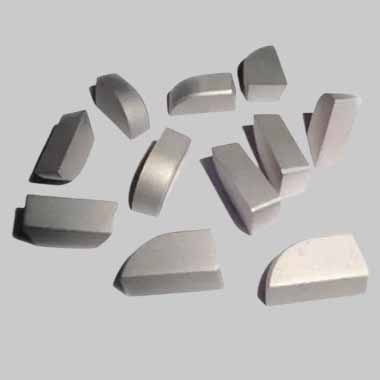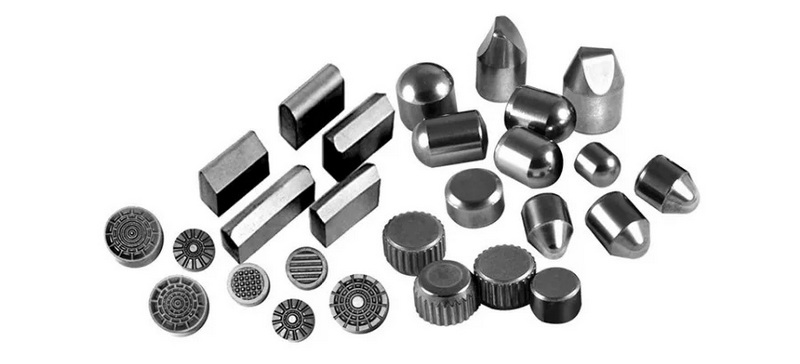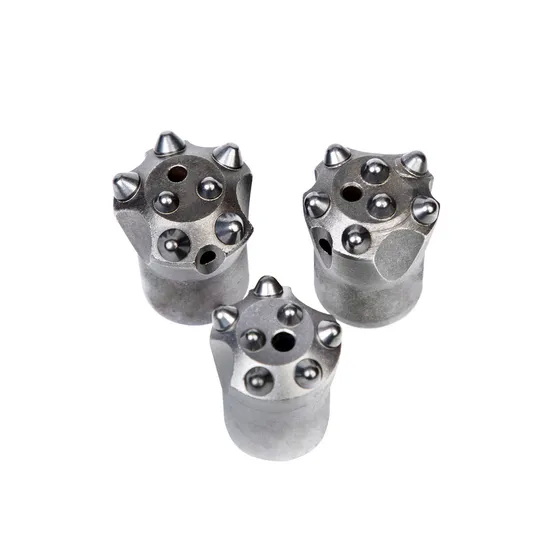Content Menu
● Understanding Tungsten Carbide and Brazing
>> What is Tungsten Carbide?
>> What is Brazing?
● Materials That Tungsten Carbide Can Braze To
>> 1. Steel (Carbon, Alloy, Tool, and Stainless Steels)
>>> Key Considerations
>> 2. Other Tungsten Carbide Parts
>>> Key Considerations
>> 3. Cast Iron
>>> Key Considerations
>> 4. Aluminum Bronze
>>> Key Considerations
>> 5. Polycrystalline Diamond (PCD) Backed with Tungsten Carbide
>>> Key Considerations
>> 6. Molybdenum and Other Specialty Metals
>>> Key Considerations
>> 7. Copper and Copper Alloys
>>> Key Considerations
>> 8. Nickel-Based Alloys
>>> Key Considerations
● Critical Factors for Successful Brazing
>> Surface Preparation
>> Filler Metal Selection
>> Joint Design
>> Heating and Cooling
● Common Applications
● Advanced Techniques and Troubleshooting
>> Induction Brazing
>> Vacuum and Atmosphere Brazing
>> Troubleshooting Common Issues
● Environmental and Safety Considerations
>> Fume Management
>> Waste Disposal
>> Health Precautions
● Conclusion
● FAQ: Frequently Asked Questions About Brazing Tungsten Carbide
>> 1. What is the best filler metal for brazing tungsten carbide to steel?
>> 2. Can tungsten carbide be brazed to stainless steel?
>> 3. Why does tungsten carbide sometimes crack after brazing?
>> 4. What joint gap is recommended when brazing tungsten carbide?
>> 5. Can tungsten carbide be brazed to non-metallic materials?
Tungsten carbide is celebrated for its exceptional hardness, toughness, and resistance to wear, making it an indispensable material in modern industry. From cutting tools to mining equipment, its utility is often maximized by securely joining it to other materials. Brazing, a process that uses a filler metal to bond two substrates without melting them, is the preferred method for attaching tungsten carbide to a variety of metals. But what materials can tungsten carbide actually braze to, and what are the key factors that determine the strength and reliability of these joints? This comprehensive guide explores the science, practicalities, and applications of brazing tungsten carbide to different substrates, providing a thorough understanding for engineers, toolmakers, and enthusiasts alike.

Understanding Tungsten Carbide and Brazing
What is Tungsten Carbide?
Tungsten carbide is a composite material formed by combining tungsten and carbon atoms, often with a metallic binder such as cobalt or nickel. This structure results in a material that is nearly as hard as diamond, with remarkable resistance to abrasion and the ability to withstand high temperatures. Tungsten carbide's unique properties make it ideal for applications where durability and longevity are paramount.
What is Brazing?
Brazing is a metal-joining process in which a filler metal with a melting point lower than the base materials is melted and distributed between them by capillary action. As the filler metal cools, it forms a strong, metallurgical bond. Unlike welding, brazing does not melt the base materials, preserving their mechanical properties and dimensional stability. The process is valued for its ability to join dissimilar materials and create joints with excellent strength and corrosion resistance.
Materials That Tungsten Carbide Can Braze To
Brazing tungsten carbide is most commonly performed to join it to various metals, with the choice of substrate, filler metal, and process conditions being crucial for a successful bond. Below, we delve into the most common and effective pairings.
1. Steel (Carbon, Alloy, Tool, and Stainless Steels)
Steel is the most frequently used material for brazing with tungsten carbide, thanks to its availability, mechanical strength, and compatibility with a wide range of filler metals.
- Carbon Steel: Commonly used for tool shanks, saw blades, and wear-resistant parts.
- Low Alloy Steel: Offers enhanced strength and toughness, making it suitable for demanding industrial applications.
- Tool Steel: Used in cutting and forming tools, requiring high hardness and wear resistance.
- Stainless Steel: Chosen for its corrosion resistance, though its oxide layer and thermal expansion characteristics require special attention during brazing.
Key Considerations
- Thermal Expansion Mismatch: Steel generally expands and contracts more than tungsten carbide, which can induce stress and lead to cracking if not managed properly. Careful selection of filler metals and joint design can mitigate these effects.
- Surface Preparation: Both steel and carbide must be thoroughly cleaned, and sometimes roughened, to ensure good wetting and adhesion by the braze alloy.
- Filler Metal Selection: Silver-based brazing alloys, often with additions of nickel or manganese, are preferred for their ability to improve wetting and accommodate thermal stresses.
2. Other Tungsten Carbide Parts
Brazing is also used to join tungsten carbide to itself, such as in the assembly of larger wear-resistant components or the repair of carbide tools. This is especially useful in the manufacture of composite tools or when replacing worn sections.
Key Considerations
- Filler Metal Compatibility: The braze alloy must wet both carbide surfaces effectively, and the choice of alloy can influence the joint's ductility and strength.
- Stress Management: Even though the thermal expansion is similar, residual stresses can still develop, so careful heating and cooling are essential.
3. Cast Iron
Cast iron is occasionally brazed to tungsten carbide, particularly in applications where wear resistance is critical, such as in agricultural or mining equipment.
Key Considerations
- Wettability: Cast iron can be more challenging to wet than steel due to its graphite content, necessitating meticulous surface preparation and the use of specialized fluxes and filler metals.
- Thermal Expansion: The mismatch is less severe than with steel, but it still requires attention to avoid joint failure.
4. Aluminum Bronze
Aluminum bronze is sometimes used as a substrate for tungsten carbide in specialized applications that require both wear resistance and corrosion resistance, such as marine or chemical processing equipment.
Key Considerations
- Oxide Layer: Aluminum bronze forms a tough oxide layer that can inhibit wetting, so aggressive fluxes or pre-treatments may be required to ensure a strong bond.
- Braze Alloy Selection: Alloys with good fluidity and the ability to wet both carbide and bronze are essential for a reliable joint.
5. Polycrystalline Diamond (PCD) Backed with Tungsten Carbide
In advanced cutting tools, polycrystalline diamond (PCD) is often supported by a tungsten carbide substrate. Brazing is used to join these materials for enhanced tool performance and durability.
Key Considerations
- Filler Metal Selection: Alloys containing nickel and/or manganese improve wetting on both PCD and carbide, ensuring a robust joint.
- Controlled Heating: Both materials are sensitive to thermal shock, so precise temperature management is crucial to prevent cracking or delamination.
6. Molybdenum and Other Specialty Metals
In high-performance or scientific applications, tungsten carbide may be brazed to molybdenum or other refractory metals. These joints are found in aerospace, defense, and research equipment.
Key Considerations
- Vacuum Brazing: Often performed in a vacuum or inert atmosphere to prevent oxidation and contamination.
- Specialty Alloys: Gold-palladium-nickel-copper-manganese alloys are sometimes used for their high-temperature strength and compatibility with both carbide and refractory metals.
7. Copper and Copper Alloys
Copper and its alloys, such as brass and bronze, can be brazed to tungsten carbide for applications requiring excellent thermal and electrical conductivity. This is common in electrical contacts, heat sinks, and certain types of wear parts.
Key Considerations
- Thermal Conductivity: Copper's high thermal conductivity can cause rapid heat loss from the joint area, making temperature control challenging.
- Oxide Formation: Copper readily oxidizes, so fluxes are essential to maintain clean surfaces during brazing.
- Filler Metal Compatibility: Silver-based alloys are often used for their excellent wetting and flow characteristics.
8. Nickel-Based Alloys
Nickel-based alloys are sometimes used as substrates in corrosive or high-temperature environments, such as chemical processing or turbine components.
Key Considerations
- Corrosion Resistance: Nickel alloys resist many forms of chemical attack, making them suitable for harsh environments.
- Brazing Temperature: Nickel alloys often require higher brazing temperatures, so the filler metal must be chosen to match both the substrate and the carbide.

Critical Factors for Successful Brazing
Surface Preparation
- Cleanliness: All surfaces must be free of oil, grease, oxides, and other contaminants to ensure proper wetting and bonding.
- Mechanical Roughening: Grinding or grit blasting the carbide surface increases surface area and improves mechanical adhesion.
- Flux Application: Fluxes protect the joint from oxidation and promote braze flow, especially important when joining materials prone to oxide formation.
Filler Metal Selection
- Silver-Based Alloys: The most common choice, often with nickel or manganese additions to enhance ductility and wetting.
- Copper-Based Alloys: Used for specific applications, particularly where cost or color is a concern.
- Tri-Foil and Composite Alloys: These layered alloys help manage stresses in large or high-impact joints by providing a ductile buffer.
Joint Design
- Gap Control: The ideal joint gap is typically 0.1–0.25 mm. This allows the filler metal to form a ductile layer that can absorb stresses from differential expansion and contraction.
- Stress Relief Features: The use of tri-foil, spacers, or pips can help maintain joint thickness and absorb expansion differences, reducing the risk of cracking.
Heating and Cooling
- Uniform Heating: Both parts should be brought to brazing temperature simultaneously to avoid uneven stresses and ensure a strong bond.
- Slow Cooling: Rapid cooling can induce thermal shock and cracking. Controlled cooling, sometimes in insulating materials, is recommended to minimize residual stresses.
Common Applications
- Cutting Tools: Saw tips, drill bits, and lathe tools frequently feature tungsten carbide brazed to steel shanks, providing superior cutting performance and longevity.
- Wear Parts: Mining, drilling, and agricultural components utilize carbide for its durability, often brazed to steel or cast iron substrates.
- Precision Molds and Dies: Carbide inserts are brazed into steel holders for extended tool life and improved dimensional accuracy.
- PCD Tools: Diamond-tipped tools with carbide backing are essential for machining non-ferrous materials and composites, offering extreme wear resistance.
- Electrical and Thermal Components: Copper or nickel substrates brazed to carbide are used in specialized electrical contacts and heat management systems.
Advanced Techniques and Troubleshooting
Induction Brazing
Induction brazing uses electromagnetic fields to heat the joint area rapidly and precisely. This method is ideal for joining tungsten carbide to metals, as it allows for localized heating, minimizing thermal stress on the carbide and substrate. Induction brazing is commonly used in automated tool production and repair, where consistency and speed are critical.
Vacuum and Atmosphere Brazing
For highly reactive or oxidation-sensitive materials, brazing may be performed in a vacuum or controlled atmosphere. This prevents oxidation, improves wetting, and produces cleaner, stronger joints. Vacuum brazing is essential when joining carbide to specialty metals like molybdenum or titanium, where even trace amounts of oxygen can compromise joint integrity.
Troubleshooting Common Issues
- Poor Wetting: Often caused by contamination or inadequate flux. Ensure all surfaces are clean and use the correct flux for the materials involved.
- Cracking After Brazing: Usually due to thermal expansion mismatch or rapid cooling. Use ductile filler metals, maintain appropriate joint gaps, and cool assemblies slowly.
- Weak Joints: May result from insufficient heating, improper filler metal selection, or inadequate joint design. Review process parameters and ensure the braze alloy is compatible with both substrates.
Environmental and Safety Considerations
Fume Management
Brazing processes can generate fumes, especially when using fluxes or heating certain alloys. Proper ventilation and personal protective equipment (PPE) are essential to protect operators from inhaling harmful substances.
Waste Disposal
Spent flux, cleaning solvents, and scrap metals should be disposed of according to local regulations to minimize environmental impact. Recycling of carbide and metal scraps is encouraged due to their high value and resource intensity.
Health Precautions
Operators should wear gloves, eye protection, and heat-resistant clothing to prevent burns and injuries. Automated or semi-automated brazing systems can further enhance safety by reducing direct human exposure to high temperatures and hazardous materials.
Conclusion
Brazing tungsten carbide to other materials is a sophisticated process that enables the use of this remarkable compound in a vast array of industrial applications. The most common substrates include various types of steel, other carbide parts, cast iron, aluminum bronze, copper alloys, nickel-based alloys, and specialty metals like molybdenum. Success depends on careful selection of filler metals, meticulous surface preparation, precise joint design, and controlled heating and cooling. Advanced techniques such as induction and vacuum brazing further expand the possibilities, allowing for the creation of high-performance assemblies in even the most demanding environments. With the right knowledge and techniques, brazed tungsten carbide joints deliver unmatched durability, reliability, and performance.

FAQ: Frequently Asked Questions About Brazing Tungsten Carbide
1. What is the best filler metal for brazing tungsten carbide to steel?
Silver-based brazing alloys containing nickel or manganese are generally preferred for joining tungsten carbide to steel. These additions improve wetting and help accommodate thermal expansion differences, reducing the risk of joint failure.
2. Can tungsten carbide be brazed to stainless steel?
Yes, tungsten carbide can be brazed to stainless steel, but special attention must be paid to cleaning the stainless steel surface and selecting a suitable flux and filler metal. Stainless steel's oxide layer and thermal expansion properties require careful process control.
3. Why does tungsten carbide sometimes crack after brazing?
Cracking is usually caused by thermal expansion mismatch between the carbide and the substrate during cooling. If the joint is too rigid or the filler metal is too strong and brittle, stresses can build up and cause the carbide to crack. Using ductile filler metals and controlling the cooling rate can help prevent this.
4. What joint gap is recommended when brazing tungsten carbide?
A joint gap of 0.1–0.25 mm is generally recommended. This allows the filler metal to form a ductile layer that can absorb stresses from differential expansion and contraction, reducing the risk of cracking.
5. Can tungsten carbide be brazed to non-metallic materials?
Brazing is primarily a metal-to-metal joining process. Tungsten carbide cannot be directly brazed to non-metallic materials such as ceramics or plastics. However, it can be brazed to metal substrates, which can then be mechanically or adhesively joined to non-metals if required.
















